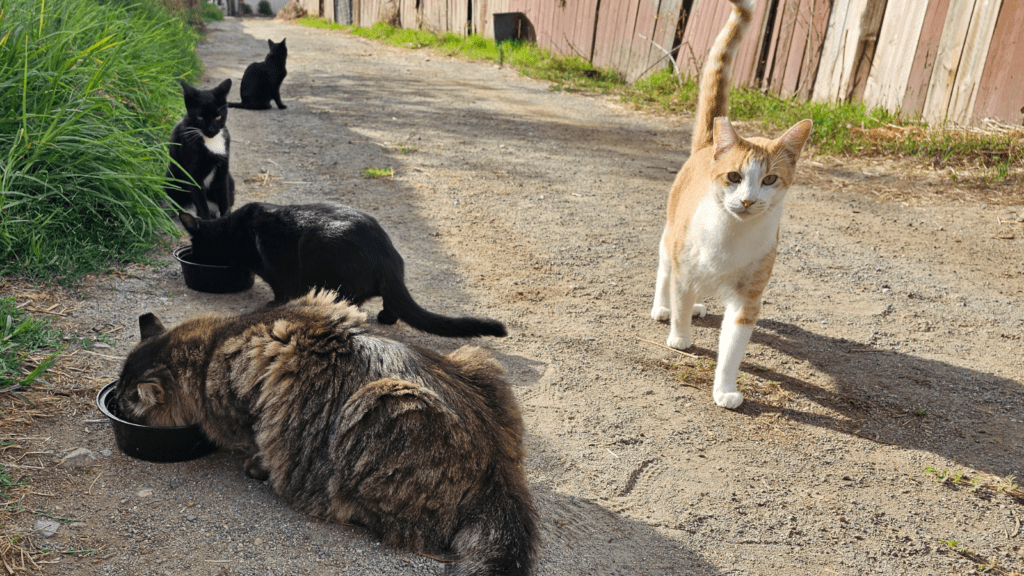
Thinking Of Adopting A Cat?
You’ll know you’re ready to adopt a cat if you have at least 30-45 minutes to spend playing with them every day, the finances to care for them (including vet care), and the ability to keep them safely indoors. Cats are social creatures, and it’s often best to adopt two cats rather than one.
Let’s dive into cat adoption more fully so you can decide if it’s right for you!
Things to know before adopting a cat
Some things to think about before adoption include:
- Adopting a shelter cat vs. from a breeder
- What age should your new cat be?
- Should you allow your cat outdoors?
We love shelter cats, rescue cats, and stray cats who are brought inside… Rescue cats are the best!
There are so many cats out there, and there’s no good reason to breed them. Even if you want a kitten, they’re plentiful at the shelters. Unfortunately, even kittens get euthanized every single day because there aren’t enough resources to care for all the cats in the world.
When it comes to age, think about your preferences for a cat. Do you want a wild pair of kittens and don’t mind if they spend their first year or two (or three or four) bouncing off the walls?
Or do you live a slower lifestyle and would prefer a senior cat who’s past those hyperactive kitten years? Do you not mind having less time with a cat so long as you can give them a good life they might not have had otherwise?
Or maybe you fall somewhere in the middle and would like to adopt a young adult cat who already knows its basic manners but still craves plenty of playtime!
Lastly, consider if you can keep your cat indoors. We recommend never allowing your cat outside unsupervised.
Indoor cats live longer and aren’t killing wildlife. However, they do need a bit of extra stimulation and attention from you to stay happy. Like all pets, cats require time and effort if you want them to live their best lives.
Am I ready to adopt a cat?
If you’re unsure if you’re ready to adopt, ask yourself these questions:
- Do I have time to play with a cat for at least 30-45 minutes every day? Cats require daily playtime to keep their minds and bodies active. This play mimics the hunting they’d do instinctually outdoors.
- Can I afford a cat? Cats need toys, scratching posts, and litterboxes. Recurring costs include food, litter, and veterinary bills.
We also recommend pet insurance or starting an emergency savings account in case your cat has a medical crisis. This can cost thousands of dollars. - Can I adopt two kittens or cats? While this isn’t necessary, it will make your life easier and enrich your cat’s life! Kittens in particular, should be adopted in pairs, especially if they are bonded.
how to prepare to adopt a cat
- Do your research! You’re already here, so we’re confident you have this one under control. Make sure you research the costs of owning a cat, regular and emergency veterinarians in your area, the benefits of keeping cats indoors, and how to care for a cat.
- Buy the essentials. This includes food and water dishes, at least two scratching posts or pads, two litterboxes (or three if you’re adopting two cats), an assortment of toys, cat food, and litter. Here are some of our favorite must-have cat products.
- Set up a room for your new cat(s). This will give them a small, safe space to transition into your home. Cat-proof the room by removing toxic items like plants and cleaners, adding in your cat’s necessities like fresh water and a litterbox, hiding or covering wires, and blocking off areas your cat could get stuck in.
- Prepare your home. Look around your home and think about how to make it the best place possible for your cat. Are there high perches where they can look down at their new kingdom? Low places for scared cats to hide (but where you can easily retrieve them if needed)?
Put away any dangers, keeping in mind that cats can climb and sometimes even open cabinets. If there’s trouble to get into, they very well might!
Also, consider how cats like to navigate their territory. You might consider “catifying” your home and ensuring they can move all around each room without touching the floor. This makes cats feel safe and helps to prevent bickering if you have other pets in the home.
The cat adoption process
- Discuss what you’re looking for in a cat. Wherever you adopt from, they’ll be better able to find you the right fit if you’re open about your lifestyle and preferences. Keep in mind, however, that kittens have less predictable temperaments than grown-up cats.
- Ask for copies of all veterinary paperwork. Your cat may have already received vaccines, a spay or neuter surgery, and other medical treatments. This is all-important for both you and your veterinarian to know.
Bringing your new cat home
- Don’t overwhelm them. It might be tempting to introduce your cat to the kids, the dog, your spouse, your other cat… But this can become incredibly overwhelming! Let them get used to their new space first.
Some cats might spend the first few days or even weeks avoiding interaction. This is okay, and you should respect their boundaries. They will eventually warm up to their new life. A general rule is that cats take about two weeks to become comfortable in a new area. - Keep them separated from other pets. It’s best to give them their own room and space. It also helps to protect your other pets until you can get the kitty to the veterinarian and ensure they’re completely healthy.
- Schedule an appointment with your veterinarian. When bringing a new cat into the household, we recommend testing them for contagious ailments like FIV and FeLV. Your veterinarian can provide more information and recommend which ailments to test for, given the cat’s history.
You should also set up an appointment to have your cat spayed or neutered if they aren’t already.
Introducing new cats
New cats should always be introduced to one another slowly. Once you’re sure they’re healthy and parasite-free, begin scent swapping.
Take an item that holds scents, like a cat bed or blanket where your cat sleeps, and put it with the other cat. Do this for both your household cats and your new cats so they can get to know one another in a safe way.
Next, try feeding meals at the closed door that separates them. This allows them to smell the other cats and even see them beneath the door, but they can’t interact enough to hurt one another. They’ll also begin to associate each other with food!
Then, you can introduce them by sight. This might mean putting a baby gate on the door and carefully guarding so that neither jump over it or allowing your new cat out while the old cat has snuggle time in your lap.
Lastly, allow them to interact with one another. Don’t micromanage—hissing, growling, and even batting at one another are normal so long as no one is hurt. They need to work things out in this way, and your intervention can damage their relationship.
Separate them if they aggressively chase, one backs another into a corner, or if things escalate physically.
Keep interactions short at first, and always supervise them together until you’re confident they can get along.



